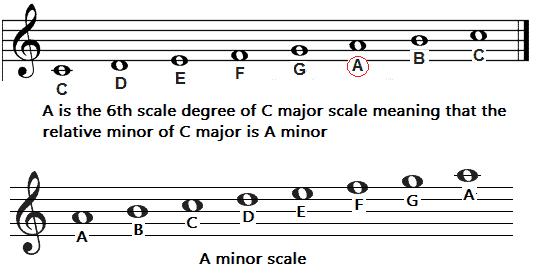Music theory, especially for the beginner – and sometimes for the intermediate as well – can be confusing. Musical scales can seem especially daunting. Major scales and minor scales, pentatonic, blues, harmonic minor, the variations are almost endless. Scales, however, are very important as they are the foundation of music itself.
The four most basic scales for contemporary music are:
- Major Scale (Natural Major Scale)
- Minor Scale (Natural Minor Scale)
- Minor Pentatonic Scale
- Blues Scale
The easiest way to begin learning is to understand 2 fundamental differences between major and minor scales. Once you have a firm understanding of that, you can then move on, building on that firm foundation.
1. Ultimate Formula
1.1. The Major Scale
Have you ever heard a vocalist warming up or seen the movie or the stage play The Sound of Music? If so, then you are no doubt familiar with do-re-mi-fa-so-la-ti-do sung with each note increasing in pitch.
Guess what? You already know the major scale, simple right? This scale can be learned in any key, but it’s easiest to start out in the key of C, because there are no sharps and flats. The notes in the C major scale are:

Now you’ll notice a pattern beginning to emerge here. The distance between C and D is one whole tone, the distance between D and E are one whole tone, but the difference between E and F is only a half-step, i.e., a semi-tone. Then between F and G, A and B are one whole tone, while the difference between B and C is again a semi-tone.
This pattern applies to the major scale in any key. Overall, there is a simple formula for major scales.

This can also be notated as:
2-2-1-2-2-2-1
where 1 represents a semi-tone (a half step) and 2 represents a whole tone (a whole step).
Using this pattern, the major scale in the key of D would be:

The major scale plays such an important part in popular music today is because so many chords can be built from the notes in the major scale. Practicing scales built on the major scale also tends to be easier because the sequences are easier to memorize and can be moved around on the fretboard without too much thought.
The major/Ionian scale is most commonly used in modern guitar for all styles of popular music.
1.2. The Minor Scale
The natural minor scale – also known as the Aeolian scale – has the same notes as its relative major scale, but is built starting from the sixth note of the relative major scale.
To illustrate, the relative minor of the C major scale is A minor.

You will notice that the pattern of tones and semi-tones is different with the minor scale. The pattern for minor scales is 2-1-2-2-1-2-2 where 1 represents a semi-tone (a half step) and 2 represents a whole tone (a whole step).

As with the major scales, this pattern remains the same regardless of the key signature.
Based on the formula, we have B minor scale:

A popular variation on the natural minor scale is the harmonic minor scale which raises the 7th note by a semitone, so in the A minor scale shown above, the G becomes a G♯. The harmonic minor scale is also a popular with metal guitarists. Marty Friedman, known for his work in Megadeth, Cacophony and Racer X, is a vocal proponent of use of the harmonic minor scale in metal.
Minor scales tend to be described as more somber and melancholy sounding, so many pieces of classical music, particularly those created for masses and requiems are composed based on the minor scale. Songs composed based on the minor scales are often highly “colored”, a prime example being Jimi Hendrix’s rendition of the Bob Dylan classic All Along the Watchtower. They can also be distinctly foreboding feeling, making it a great option for songs like Santana’s Evil Ways and Booker T. Jones’ Born Under a Bad Sign.
2. The Interval & Tone (The Most Vital)
The BIGGEST difference between major and minor scale you should know is the 3rd note. More specifically, that is the distance between the root note and the 3rd note: In major scale, the distance is 2 steps, also called a major 3rd interval and in minor scale, the distance is one and a half step, also called a minor 3rd interval.
The best way to see this difference is listening to these sound samples:
Major 3rd interval
Minor 3rd interval
It’s easy to see that a minor 3rd is one note lower than a major 3rd (a half step). These intervals make the typical tone of those scales. In details, major scales produce bright tones and ‘happy feelings’, but minor scales produce darker tones as well as ‘sad feelings’.
Let’s take some examples for C Major and Minor scales:
C Major Scale
C Minor Scale:
3. What You Need To Understand Next?
Due to their significant role mentioned above, when expanding to more advanced types of scale (Major/Minor pentatonic scale, blues scale …) and comparing with the natural major/minor scales, you should notice that 2 scales, which have the same root note, may have different notes because it may be removed, replaced by other notes having higher or lower step, but the 3rd note (o) always remains although its position in the advanced scales might be changed.
For example:
– A natural minor scale: A (Root note) – B – C (3rd note)- D – E – F (6th note) – G – A
– A minor pentatonic scale: A (Root note) – C – D – E – G – A (Comparing with A natural minor scale, the 6th note is removed but the 3rd note still remains although its new position is down to the 2nd).
– A natural major scale: A (Root note) – B – C# (3rd note) – D – E – F# – G# (7th note) – A
– A major pentatonic scale: A – B – C# – E – F# (Comparing with A natural major scale, the 7th note is removed but the 3rd note still remains).
4. It’s Hard! Why Is It So Important?
By this time it’s understandable that your head might be about to explode, but we hope we’ve opened up some new possibilities for you. Improvisation is great and it’s very possible to write songs without knowing theory, but it opens up so much more when you understand why something sounds good and how it all works.
It’s not something that you have to do all at once either. Take it in small pieces. When you were first learning to play, you didn’t jump right into Steve Vai solos, it was a process. The same applies to learning all of the scales and modes.
Start slowly and build your knowledge. I promise you that, down the road, you’ll be glad you did.